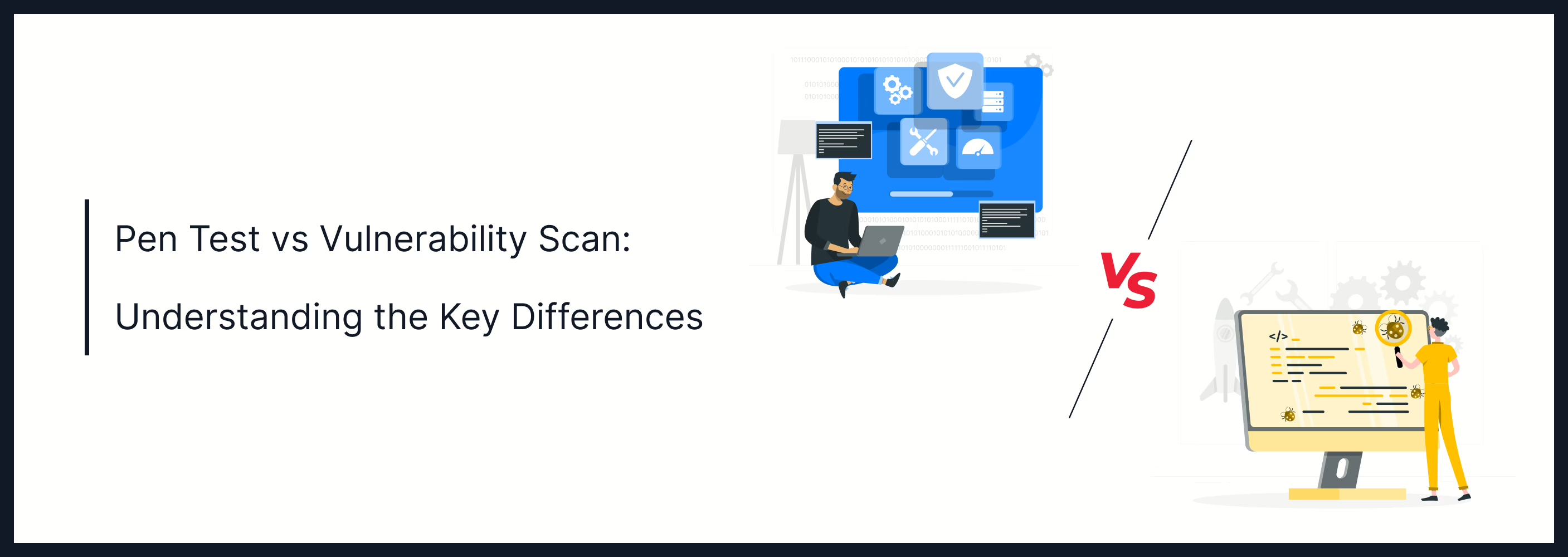
Oct 15, 2024 Information hub
Pen Test vs Vulnerability Scan: Understanding the Key Differences in Cybersecurity
In today’s digital age, cybersecurity is no longer a luxury but a necessity. With the increasing number of cyberattacks, data breaches, and sophisticated hacking techniques, organizations must be proactive in securing their digital assets. Two of the most common methods used to assess the security posture of an organization are penetration testing (pen test) and vulnerability scanning. While both are essential tools in the cybersecurity toolkit, they serve different purposes and provide different insights.
In this blog post, we will explore the key differences between a pen test vs vulnerability scan, their relevance in today’s cybersecurity landscape, and how organizations can leverage both to strengthen their defenses. By the end of this post, you will have a clear understanding of when to use each method and how they complement each other in a comprehensive security strategy.
The Relevance of Cybersecurity Today
Before diving into the specifics of pen tests and vulnerability scans, it’s essential to understand why these practices are more critical than ever. According to a report by Cybersecurity Ventures, cybercrime is expected to cost the world $10.5 trillion annually by 2025. This staggering figure highlights the growing threat landscape that businesses face, regardless of their size or industry.
Key Cybersecurity Statistics:
- 43% of cyberattacks target small businesses.
- The average cost of a data breach in 2021 was $4.24 million (IBM).
- Ransomware attacks increased by 150% in 2020, with an average ransom payment of $170,000 (Sophos).
Given these alarming statistics, organizations must adopt a proactive approach to cybersecurity. This is where pen tests and vulnerability scans come into play, helping businesses identify and address potential weaknesses before they can be exploited by malicious actors.
What is a Vulnerability Scan?
Definition and Purpose
A vulnerability scan is an automated process that identifies known vulnerabilities in an organization’s systems, networks, and applications. It involves using specialized software to scan for security flaws, misconfigurations, and outdated software that could be exploited by attackers.
The primary goal of a vulnerability scan is to provide a comprehensive overview of potential security weaknesses. It is a broad and shallow approach, meaning it covers a wide range of systems but does not delve deeply into each one.
How Vulnerability Scans Work
Vulnerability scans typically follow these steps:
- Asset Discovery: The scanner identifies all devices, systems, and applications within the network.
- Vulnerability Identification: The scanner compares the discovered assets against a database of known vulnerabilities (such as the Common Vulnerabilities and Exposures (CVE) database).
- Reporting: The scan generates a report that lists all identified vulnerabilities, often ranked by severity.
Types of Vulnerability Scans
There are several types of vulnerability scans, each serving a specific purpose:
- Network Scans: Focus on identifying vulnerabilities in network devices such as routers, switches, and firewalls.
- Web Application Scans: Target web applications to identify issues like SQL injection, cross-site scripting (XSS), and insecure authentication mechanisms.
- Database Scans: Examine databases for misconfigurations, weak passwords, and outdated software.
- Host-Based Scans: Focus on individual devices, such as servers and workstations, to identify vulnerabilities in the operating system and installed software.
Benefits of Vulnerability Scans
- Automated and Fast: Vulnerability scans are automated, making them quick and efficient. They can scan large networks in a relatively short amount of time.
- Comprehensive Coverage: Vulnerability scans cover a wide range of systems and applications, providing a broad view of an organization’s security posture.
- Cost-Effective: Since they are automated, vulnerability scans are generally more affordable than manual testing methods like penetration testing.
Limitations of Vulnerability Scans
- False Positives: Vulnerability scans can sometimes flag issues that are not actual vulnerabilities, leading to unnecessary remediation efforts.
- No Exploitation: Vulnerability scans do not attempt to exploit the identified vulnerabilities, meaning they cannot determine the real-world impact of a vulnerability.
- Limited Depth: While vulnerability scans cover a wide range of systems, they do not provide in-depth analysis or insights into how vulnerabilities could be exploited.
What is a Pen Test?
Definition and Purpose
A penetration test (pen test) is a simulated cyberattack conducted by security professionals (often called ethical hackers) to identify and exploit vulnerabilities in an organization’s systems, networks, or applications. Unlike vulnerability scans, pen tests are manual and deep, meaning they focus on a specific target and attempt to exploit vulnerabilities to determine their real-world impact.
The primary goal of a pen test is to simulate the actions of a malicious attacker and assess how well an organization’s defenses hold up under real-world attack scenarios.
How Pen Tests Work
Penetration testing typically follows these steps:
- Planning and Reconnaissance: The tester gathers information about the target, such as IP addresses, domain names, and network architecture.
- Scanning: The tester uses tools to identify potential vulnerabilities in the target systems.
- Exploitation: The tester attempts to exploit the identified vulnerabilities to gain unauthorized access to systems, data, or applications.
- Post-Exploitation: The tester assesses the impact of the successful exploit, such as whether sensitive data can be accessed or critical systems can be disrupted.
- Reporting: The tester provides a detailed report outlining the vulnerabilities discovered, the methods used to exploit them, and recommendations for remediation.
Types of Pen Tests
Penetration tests can be categorized based on the scope and knowledge of the tester:
- Black Box Testing: The tester has no prior knowledge of the target environment, simulating an external attacker with no insider information.
- White Box Testing: The tester has full knowledge of the target environment, including network diagrams, source code, and system configurations. This simulates an internal attacker or a malicious insider.
- Gray Box Testing: The tester has partial knowledge of the target environment, simulating an attacker with some insider information, such as a disgruntled employee.
Benefits of Pen Tests
- Real-World Simulation: Pen tests simulate real-world attack scenarios, providing valuable insights into how an attacker could exploit vulnerabilities.
- In-Depth Analysis: Pen tests go beyond identifying vulnerabilities; they assess the actual impact of exploiting those vulnerabilities.
- Customizable: Pen tests can be tailored to focus on specific systems, applications, or attack vectors, providing a more targeted assessment.
Limitations of Pen Tests
- Time-Consuming: Pen tests are manual and require significant time and effort to conduct, especially for large or complex environments.
- Expensive: Due to the expertise and time required, pen tests are generally more expensive than vulnerability scans.
- Limited Scope: Pen tests typically focus on a specific target or set of systems, meaning they may not provide a comprehensive view of an organization’s overall security posture.
Pen Test vs Vulnerability Scan: Key Differences
While both pen tests and vulnerability scans are essential components of a robust cybersecurity strategy, they serve different purposes and provide different insights. Here’s a breakdown of the key differences between a pen test vs vulnerability scan:
| Aspect | Vulnerability Scan | Pen Test |
|---|---|---|
| Purpose | Identify known vulnerabilities | Simulate real-world attacks and exploit vulnerabilities |
| Methodology | Automated | Manual |
| Depth | Broad and shallow | Narrow and deep |
| Exploitation | No | Yes |
| Time and Cost | Fast and cost-effective | Time-consuming and expensive |
| Frequency | Regular (weekly, monthly, quarterly) | Periodic (annually or after major changes) |
| Output | List of vulnerabilities ranked by severity | Detailed report with exploit methods and impact analysis |
Practical Examples and Case Studies
Case Study 1: Vulnerability Scan in Action
A mid-sized e-commerce company conducted a vulnerability scan on its web application and network infrastructure. The scan identified several outdated software versions and misconfigurations in the firewall. By addressing these issues, the company was able to reduce its attack surface and prevent potential exploitation by attackers.
Case Study 2: Pen Test in Action
A financial institution hired a penetration testing firm to assess the security of its online banking platform. The pen testers discovered a critical vulnerability in the authentication mechanism, allowing them to bypass login controls and access customer accounts. The institution quickly patched the vulnerability, preventing a potential data breach that could have resulted in significant financial and reputational damage.
Current Trends and Challenges
Trends
- Automated Pen Testing: With advancements in artificial intelligence (AI) and machine learning, automated pen testing tools are becoming more sophisticated, allowing organizations to conduct pen tests more frequently and at a lower cost.
- Integration with DevSecOps: As organizations adopt DevSecOps practices, vulnerability scanning and pen testing are being integrated into the software development lifecycle (SDLC) to identify and address security issues early in the development process.
Challenges
- Skill Shortage: There is a significant shortage of skilled cybersecurity professionals, making it difficult for organizations to find qualified pen testers.
- False Sense of Security: Organizations that rely solely on vulnerability scans may develop a false sense of security, as these scans do not provide insights into how vulnerabilities could be exploited in real-world scenarios.
Benefits of Combining Pen Tests and Vulnerability Scans
To achieve a comprehensive security posture, organizations should use both pen tests and vulnerability scans. Here’s why:
- Vulnerability scans provide a broad overview of potential security weaknesses, allowing organizations to address known vulnerabilities quickly.
- Pen tests simulate real-world attacks, providing insights into how vulnerabilities could be exploited and the potential impact on the organization.
By combining both methods, organizations can identify and address both known and unknown vulnerabilities, ensuring a more robust defense against cyber threats.
Conclusion
In the battle against cyber threats, both pen tests and vulnerability scans play crucial roles. While vulnerability scans provide a broad and automated assessment of known vulnerabilities, pen tests offer a deeper, manual exploration of how those vulnerabilities could be exploited in real-world scenarios.
To maintain a strong security posture, organizations should not view these two methods as mutually exclusive but rather as complementary tools. Regular vulnerability scans can help identify and patch known issues, while periodic pen tests can provide a more in-depth analysis of potential attack vectors and their real-world impact.
Actionable Takeaways:
- Conduct regular vulnerability scans to stay on top of known vulnerabilities and misconfigurations.
- Schedule periodic pen tests to simulate real-world attacks and assess the effectiveness of your security defenses.
- Integrate both methods into your overall cybersecurity strategy to ensure comprehensive protection against evolving threats.
By leveraging both pen tests and vulnerability scans, organizations can stay one step ahead of cybercriminals and protect their valuable digital assets.
By understanding the differences between pen test vs vulnerability scan, businesses can make informed decisions about their cybersecurity strategies and ensure they are well-prepared to defend against the ever-evolving threat landscape.
